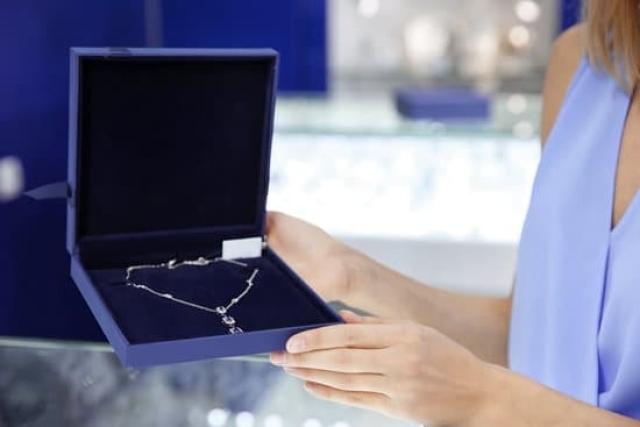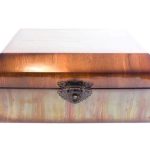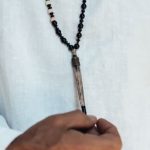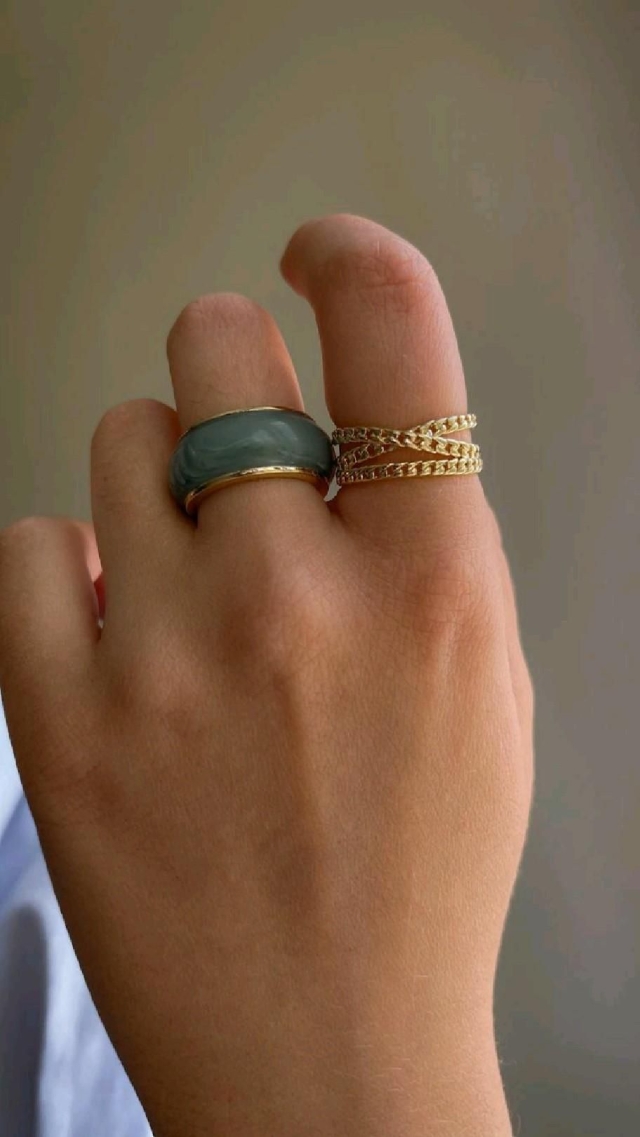When you hear the term ‘vintage jewelry’ most people think of antique pieces, however in actuality vintage jewelry is classified as any piece that pre-dates 1960. Vintage jewelry is not just older, but it is also made of different materials than what we use today in costume and fine jewelry. In order to repair vintage jewelry properly, it is important to understand how it was originally created and what materials were used.
Common Jewelry Materials – Metals, Stones, Pearl and Shells
The base of most vintage jewelry pieces are metal components such as copper or brass. Silver or gold was often applied in the form of plating for protection or simply for beauty. The popular stones used in this era were typically glass cabochons, rhinestones and paste stones that were made out of leaded glass.
Pearls were a very popular choice during this time period but they can be very delicate making them tricky to repair. Until synthetic materials became more readily available, shells were also a favorite material used by jewelers creating branded pieces in the 1950’s and prior.
Repair Tips for Vintage Jewelry
Once you have identified the age and material of your vintage jewelry it is time to turn your attention to learning how to make repairs. It can be difficult finding replacement parts for older pieces so many experts recommend soldering instead of replacing with glue where possible.
Many stones have become brittle over time so you will need to test them cautiously before attempting any repairs because if the stone cracks or breaks it can be near impossible to replace with an identical one.
Always be mindful when dealing with pearls since they are so fragile and if heated too quickly or too much they will darken significantly in color which some may want to avoid at all costs. Additionally as these types of components are delicate there are certain methods you will want to steer clear from like submerging things in water as that could ruin a piece entirely.
Conclusion
Understanding what materials were used to create certain pieces and how those materials react under certain conditions is key when attempting any type of repair on vintage jewelry items. Ultimately it takes patience, knowledge and skillful technique when working on vintage jewelry repairs; whether its replacing a stone setting or traditional soldering they both require accurate measurements and care while doing the job right.
With enough practice, patience and skill labor anyone will eventually have the ability learn how to repair vintagejewelry safely.
Preparing for the Repair
Repairing vintage jewelry can be a rewarding and satisfying experience, as it grants you the ability to bring an old piece back to life. Before starting your repair, you should make sure that you have the proper tools available to finish the job safely. Make sure to gather items such as needle-nose pliers, small screwdrivers and tweezers when undertaking such a job.
It’s also important that you find yourself a comfortable and safe working space that offers enough room for you to maneuver, while also providing adequate lighting so that you can properly inspect your work. If possible, try to find a table or desk located in an area without high levels of humidity or moisture, as they could cause further damage if not kept properly ventilated.
Once the essential supplies are gathered and a proper workspace is found, inspect the item in order to locate any breaks or cracks that need repairing. All improvements begin with taking apart the piece in order to allow for easier access during maintenance or practical repairs.
Make sure that each part is removed carefully, so no further damage is done. After each part has been taken off, lay them all out on your workstation – this will help prevent accidental mixing up of pins, clasps and other parts from different pieces during the actual repair process.
The last step before actually starting the repair is to assess what needs fixing and tailor your plan accordingly. Examine each part for wear and tear before running tests for structural integrity; more often than not there are tiny cracks which were previously overlooked due to their small size making them hard to spot at first glance.
Take your time and make note of any deficiency found while going through this period of inspection – knowing what requires repairing well ahead of time will help turn out great results faster since these matters require precision when handling delicate pieces of jewelry.
Assessing and Diagnosing the Damage
When it comes to repairing vintage jewelry, it is important to assess the type of damage that has been done. This will help determine the best way to proceed with the repair. Examining a piece of vintage jewelry can sometimes reveal what kind of repair might be needed; are any stones missing, have any settings become loose or broken, or is there discoloration on the metal?
These all could give an indication as to what needs to be fixed and will require different techniques depending on the particulars found. An accurate estimate of repairs may need to be made by an experienced jeweler in order for them to have an understanding of what needs to be done.
If a client were apprehensive about taking their item somewhere, they could start by being sure that all parts are securely fastened together and that clasps are functioning properly before going ahead with further work.
Using Appropriate Tools for Repairs
It is important for anyone attempting repairs on vintage jewelry to make sure that they’re using correct tools for the job at hand. If too large of tools are used, this could cause damage if parts become squished or bent out of shape when working with prongs and wires.
To avoid this from happening, tools should either fit snugly in the area being worked on or use soft-tipped pliers so as not to cause harm while handling delicate pieces. For example, heavier and sturdier pieces like brooches should not require fine-tipped tweezers whereas earrings may benefit from having such tools utilized since some settings can be small in size.
Cleaning and Polishing
In addition to assessing damages, one should always remember about cleaning vintage pieces prior to starting repairs so that any dirt or tarnish been removed without further problem during the process. The cleaning solution used will depend on if gemstones were present or not; if none were found then light soap and warm water would be sufficient whereas a specialized cleaner would need to be employed when stones are involved due toe their fragility.
Furthermore, an antiqued patina may exist upon delicate settings so making sure those spots are handled carefully so as not cause dents or chips would help ensure a successful job afterward with regard to polishing off pieces afterward because it allows one to see any new scratches upon completion which can then be buffed away before being shipped back off.
Cleaning and Assessing the Integrity of the Metal
Vintage jewelry can be both valuable and cherished items, so when damage occurs it is important to understand how to repair vintage jewelry. Restoring a piece of jewelry from its original condition may require some skills, tools, and patience. The first step should always be cleaning the piece and assessing the integrity of the metal.
When cleaning antique and vintage jewelry, you want to avoid harmful chemicals or abrasive materials that could damage it further. Use a soft bristled toothbrush with a mild soap or warm water solution or simply use a damp cloth.
When working with plated metals be sure to go very gently as there may be layers of different metals in varying states of wear. If you have doubts about any part starting to wear away then you should not try to clean it yourself but seek out a trained professional for evaluation.
Assessing the integrity of the metal is crucial for safety reasons as well as getting an exact idea of what kinds of repairs need done on your item. This involves looking closely at any parts that appear weak, brittle, or fragile; checking for gaps in soldered areas; watching for discolorations around link pins; and inspecting fasteners or stone settings for wear.
Many experienced jewelers will inspect these items prior to even attempting work being done on them if these issues aren’t addressed properly it increases the chances of further damage or dangerous wearing down of pieces over time after they are used repeatedly.
You also want to note any pieces that may need replaced such as missing fastenings like earring clasps, broken links on necklaces, missing stones from settings etc., all before beginning repairs.
After necessary parts are identified then you can decide if it is possible for you make those fixes yourself with easy-to-find tools like pliers and cutters – along with the patience required – or if you trust unleashing more complicated tasks but leaving it up to more experience/professional hands will yield better-quality results.
Replacing and Repairing Settings, Clasps and Stones
When repairs on vintage jewelry are needed, the first step is to assess the damage. Many jewelers provide repair services for vintage pieces, but for some minor fixes one can often do it themselves. In case of replacing and repairing settings, clasps and stones it is important that any replacements selected should be as close to original design and metal as possible so that the item retains its original integrity and charm.
One of the more commonly encountered jewelry repair jobs – replacing missing stones or resetting existing stones – is a task which even an amateur can manage with moderate success. There are several basic tools required, such as a soldering iron, flat pliers, round pliers and even a magnifying lamp.
It’s also useful to have small jars or containers handy in which to store small parts like missing prongs that can easily be dropped or misplaced. A bench pin is recommended for flattening out misshapen prongs which need to be refitted over new or existing stones.
To ensure all settings are secure prior to soldering one should always check if any prongs or pieces are loose or bent, before tightening them with flat-nosed and then round-nosed pliers where necessary.
Local hardware stores offer a selection of settings ideal for use on both odd shaped and more common stone types; however if replacement of similar style settings cannot be located they can usually be custom made by a jewelry manufacturer or supplier at an extra cost.
For more complex problems beyond the scope of basic repairs like re-stringing pearls, it would be best left up to an experienced jeweler who specialized in the arena of vintage jewelry restoration and repair work in order to ensure proper procedures are carried out efficiently; minimizing risk damage from unforeseen circumstances when working on delicate items from past centuries.
Re-Stringing the Piece with New Thread and Beads
Re-stringing a broken or worn vintage jewelry piece is one of the most common repair techniques. It can be used to restore and preserve pieces of jewelry that still have strong meaning, even if they are broken or extremely outdated. To do this, you will first need to get an idea of what the item originally looked like and the materials it was composed of.
After gathering materials such as thread and beads, you’ll want to start by gently breaking apart any existing threads using tweezers or small scissors. Ensuring each bead is accounted for during this step will prevent any damage being done to other beads in the process. Once all beads are properly separated, sort through them and inspect them for any excessive wear or tears that may need to be repaired prior to re-stringing.
Now you’re ready to start bringing your vintage jewelry piece back together. Begin by knotting one end of string so that individual beads won’t slip off, then carefully thread the beads through the knotted end. Consider playing around with your beads to create a patterned look that would heavily resemble its original design.
Some extra touches like spacers can add dimensional texture as well as help make sure that each bead has an equal amount of space in between it and the next bead or spacer – if applicable. Now tie off both ends with the same knot used at the beginning; This will guarantee proper fastening throughout wear and tear without compromising structural integrity right off the bat.
Refinishing and Buffing for a Fresh Look
Vintage jewelry is an heirloom that can be handed down to generations. The older pieces of jewelry can often times become worn, reducing their overall aesthetic and collectible value. To repair these items and bring them back up to snuff, it is likely necessary for the piece of jewelry to go through a few refinishing steps.
The first step in repairing vintage jewelry is buffing and polishing. This process involves using fine grit sandpaper in combination with a rotation lathe or muslin wheel or something similar in order to even out scratches and other imperfections that have settled on the pieces.
For softer metals, like gold, this process should be done very carefully as too much buffing could tear away parts of the metal. It is possible to buff by hand but for best results, a professional should be used.
Once the refinishing process has been completed there needs to be some sort of protective coating placed on the item of jewelry in order to prevent any future wear and tear damage from occurring. Depending upon the material of choice this can range from delicate oils such as perishable oil or non-perishable coatings such as diamond-based ones.
Whatever type of coating chosen, it must also suit the design details within the vintage item itself, allowing beauty alongside protection during daily wear without being detrimental to either material types involved in its creation.
The restoration process will give antique jewelry a whole new lease of life and make sure that those cherished heirlooms can be passed down from generation to generation. Lastly, if any necessary repairs are needed beyond what basic refinishing or buffing can accomplish, it is important to seek out professional help for these services as attempting for oneself may cause irreversible damages on jewelry that cannot be repaired otherwise.
Caring for and Protecting the Jewelry Long-term
When it comes to caring for and protecting vintage jewelry, people should take the time to properly assess the jewelry’s current condition. Look for loose settings and check whether any of the materials used, such as stones and metals, have marked or corroded.
If so, it’s important to act quickly before more permanent damage is done. The best way to address any potential problems is by taking the pieces to a professional jeweler who can inspect them thoroughly and determine what repairs need to be made.
It’s also important to engage in preventative measures for ongoing protection of vintage jewelry. People can preserve their pieces for many years by following some basic steps that ensure optimal care. For one thing, it’s best to store jewelry away from direct sunlight or excessive heat that could negatively affect its structure and appearance over time.
Also, storing each piece separately ensures less chance of scratches on related pieces that are stored together. Storing jewelry in air-tight containers is another helpful tip; this will protect delicate gemstones from moisture damage which can occur if humidity levels get too high in certain environments.
In addition to storage methods, proper cleaning routines are also essential if you want your vintage jewelry pieces to remain looking their best for years to come. Jewelry should never be cleaned with harsh chemicals as this can damage delicate surfaces; instead use an old toothbrush and warm water with a bit of mild soap if necessary.
Rinse off the piece with water after cleaning and then lay out flat on a soft surface like a towel or foam board so it can dry completely without being disturbed or misshaped due to accidental contact during drying processes. With these simple tips anyone should be able to keep their precious items safe for many generations to enjoy their beauty and craftsmanship.

Welcome to my jewelry blog! My name is Sarah and I am the owner of this blog.
I love making jewelry and sharing my creations with others.
So whether you’re someone who loves wearing jewelry yourself or simply enjoys learning about it, be sure to check out my blog for insightful posts on everything related to this exciting topic!





